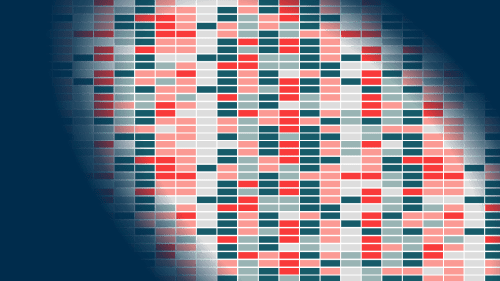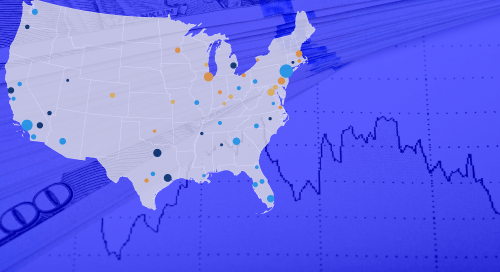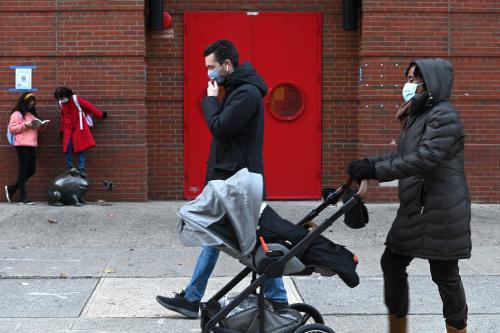America is now firmly in the grips of what many are calling the “third wave” of the COVID-19 pandemic. Each day, new COVID-19 cases nationwide routinely approach or exceed 200,000, and associated deaths hover around 2,000.
In reality, however, each wave of the pandemic within the United States has been a regional one. The first wave, in March and April, was centered largely in Greater New York and New England, among the locations where the virus first hit U.S. shores. The second wave, which peaked in July, most affected metro areas in the South and West, after many relaxed their social distancing measures just as the virus began to take root in their communities.
My colleague William H. Frey documents that nearly all metro areas (and rural areas, too) are now experiencing increasing COVID-19 cases. That noted, the third wave thus far has hammered the Midwest most of all. And the region’s metro areas are suffering an associated economic toll, as indicated in the latest data from our Metro Recovery Index, which tracks the real-time economic conditions in 192 metro areas across the United States.
Rising caseloads are concentrating in Midwestern metro areas
Until the fall, the pandemic’s impact in the Midwest had been lower than in other regions. But between September and November, the combined average daily new case rate (per 100,000 population) across Midwestern metro areas rose fivefold, from 14.2 to 71.7.
The Midwest is home to the six metro areas that saw the largest COVID-19 case increases over that period, and 13 of the top 20. Midsized metro areas such as Cedar Rapids, Iowa, Fort Wayne, Ind., and Peoria, Ill., as well as very large metro areas such as Grand Rapids, Mich., Milwaukee, and Minneapolis-St. Paul, registered especially large spikes. Despite accounting for only 18% of the combined population across the 192 metro areas, Midwestern metro areas accounted for 33% of their new COVID-19 cases in November.

Case rates spiked in the three other regions as well, though not nearly to the degree they did in the Midwest. By November, average case rates in Northeast, South, and West metro areas were less than half those of Midwestern metro areas. Nonetheless, rates in each of those regions were higher than at any other point so far during the COVID-19 pandemic.
Economic activity contracted fastest in the Midwest
As COVID-19 cases spiked in the Midwest in November, consumers and businesses in the region pulled back. While we don’t yet have official metropolitan data on jobs and unemployment for November, other indicators point to a significant slowdown.
For instance, many of the metro areas in which November’s average case rates rose the most saw the steepest drops in workplace visits, according to data from Google’s Community Mobility Reports. Visits were down in nearly every metro area, but fell by the largest margins in metro areas in Michigan, Iowa, and Minnesota. Midwestern metro areas accounted for many of those registering significant declines in workplace-related travel.

Small businesses in Midwestern metro areas also faced negative impacts from rising caseloads. None of the nation’s 50 largest metro areas (for which data are available) saw an increase in the percentage of its small businesses that were open in November. Closure rates were highest, however, in Indianapolis, Chicago, Milwaukee, and several other Midwestern metro areas. By November, one-third of Detroit’s small businesses were shuttered compared to January, a decline matched by only the Boston and San Francisco metro areas.

Metro areas need economic help, stat
With COVID-19 cases reaching unprecedented levels in November—and many more cold months to come in the Midwest—a robust economic recovery is not in the near-term forecast. Vaccines will take months to sustainably lower virus levels, and even after that, Americans will be understandably cautious in their travel and spending.
The pandemic’s toll on metropolitan health and economic activity—in blue states (Michigan, Minnesota) and red states (Indiana, Iowa), as well as in large cities (Chicago, Milwaukee) and midsized regions (Cedar Rapids, Sioux Falls, S.D.)—provides a stark reminder that places of all sizes and political persuasions need immediate, significant federal assistance to avoid disastrous economic damage, and to safely navigate COVID-19’s latest deadly wave.
-
Acknowledgements and disclosures
Sarah Crump and MaryAnn Placheril provided valuable research assistance.







Commentary
COVID-19’s third wave is hammering the Midwest
December 11, 2020